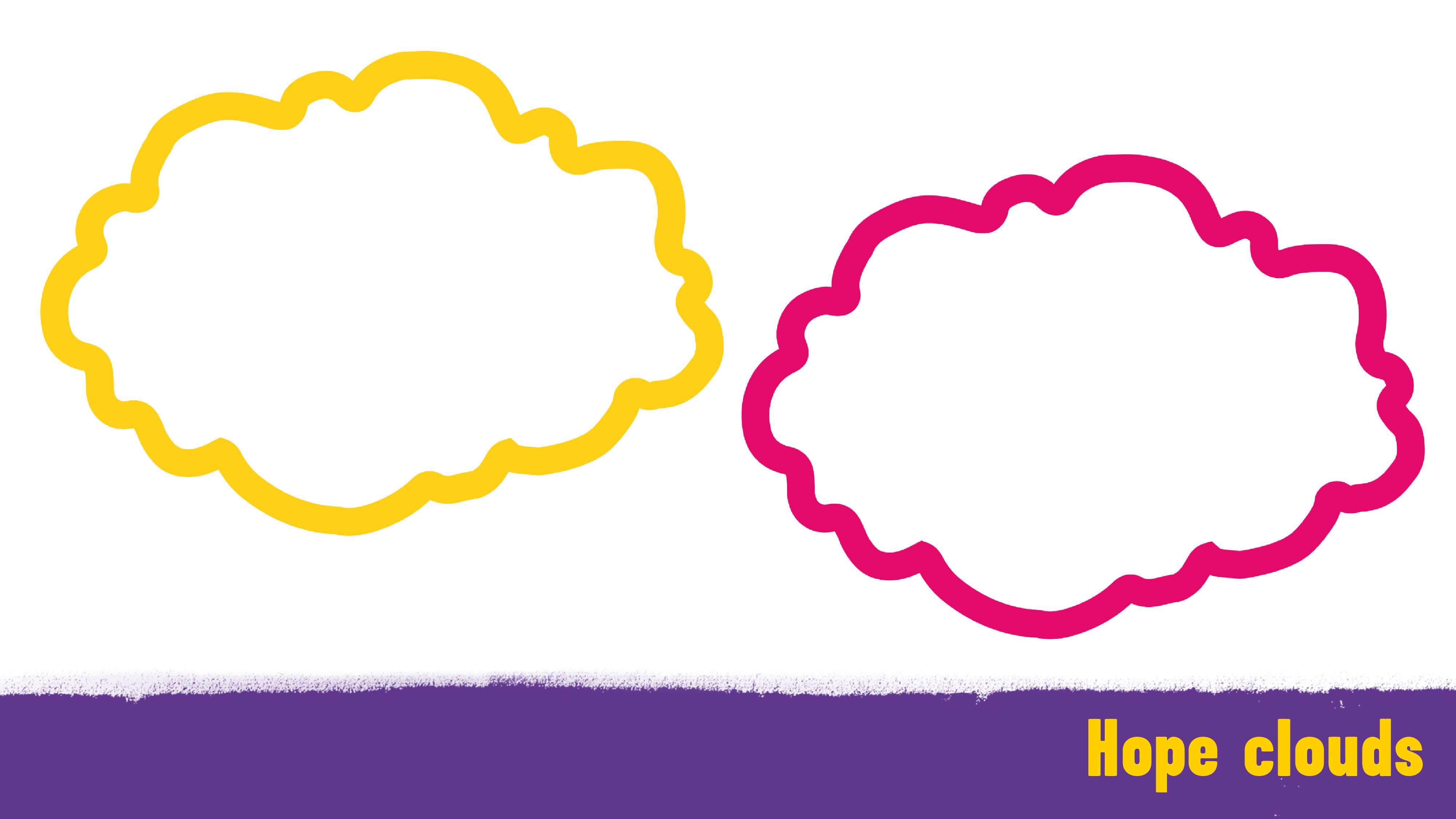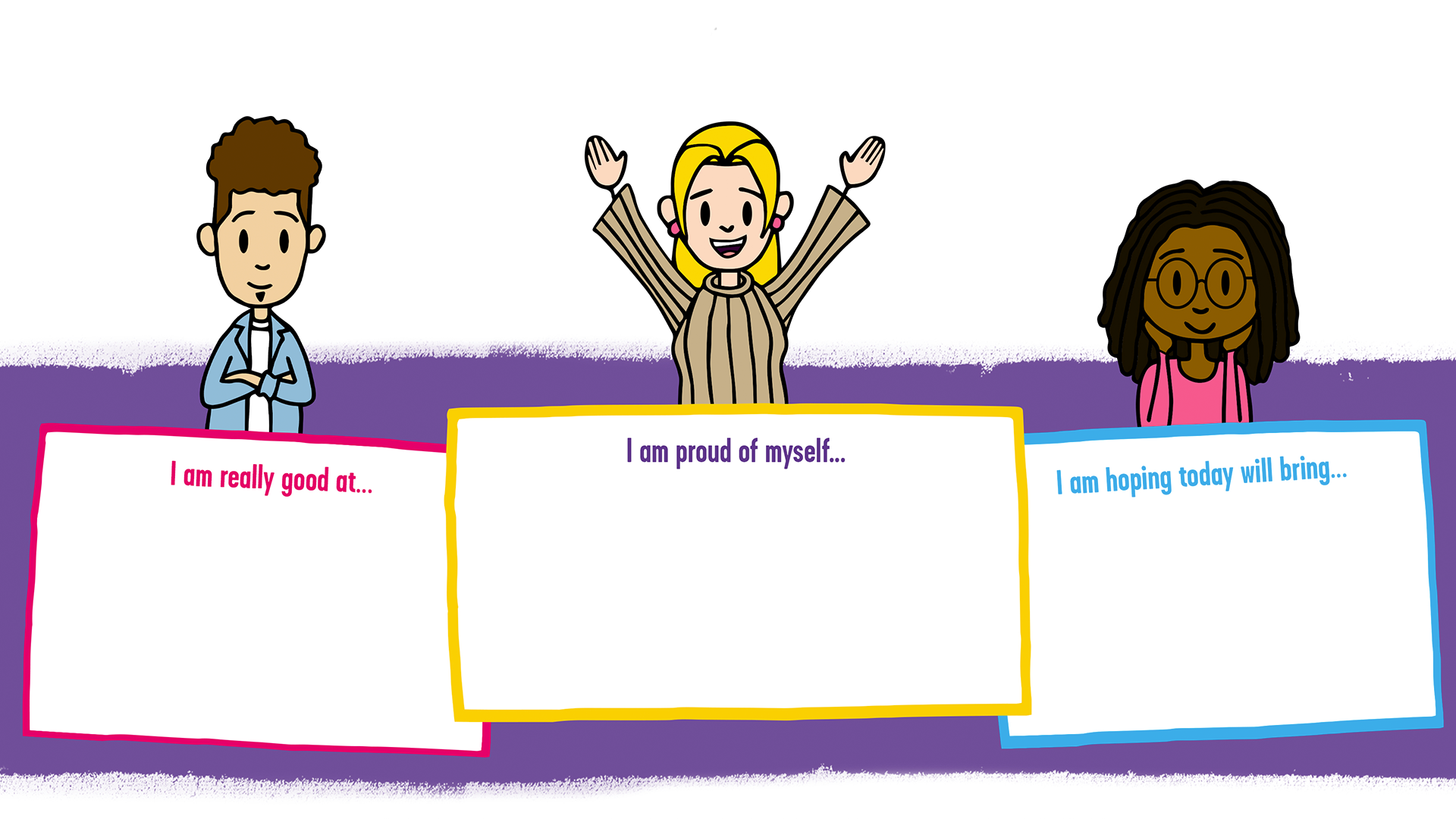
- For:
- Community support,
- Youth workers
Activities for professionals and volunteers working with young people to help build positive mental health and wellbeing in a range of settings. This includes downloadable worksheets and instructions on how to use these activities one-to-one or in larger groups.

We know that teachers, youth workers and community group leaders all play a role in helping young people and children talk about their mental health. We also know that learning, continuous support and encouragement, and a sense of achievement, are ways of improving mental health and wellbeing.
From sports clubs to the classroom, these activities can be adapted to help children and young people build positive mental health.

A preview of the chatterbox chat resource with written questions and statements including: 'Who can you talk to when you feel lonely or worried?', 'Tell me a positive motto!', 'One thing you are looking forward to', 'Think of acts of kindness to do this year', 'One new thing you will try this year' and 'Three things that will help your wellbeing'.
This is a great activity to talk about feelings and get young people sharing their ideas. Having a game, puzzle or activity to focus on can help a young person feel more comfortable talking about something for the first time, as it moves the focus off the young person onto the activity. In a one-to-one session, this can be particularly helpful if the topic is new to a young person. In a group setting, this activity allows young people to share ideas with each other.
Document type: PDF Document size: 0.2MB
1. Cut out the chatterbox chat template along the dotted line.
2. Flip the template over so the blank side is facing up.
3. Fold diagonally in half (starting from the bottom left corner, fold your chatterbox so the bottom left corner meets the top right corner). Your chatterbox should make a triangle. Crease the edge well.
4. Unfold the chatterbox, and do the same thing but starting with the bottom right corner (folding the activity picker in half diagonally). You should now have a creased point in the middle.
5. Stay on the blank side and fold each corner so the points meet in the middle. Your chatterbox will now look like a smaller square.
1. Slot your thumbs and first fingers under the flaps of the chatterbox and find a partner to start chatting. Your fingers/thumbs will be touching under the paper.
2. Pick one of the words on the flaps e.g. feelings/talk/physical/wellbeing and spell this out while moving your index fingers apart from your thumbs for letter one, then your right hand digits away from your left hand for letter two etc. Continue in this pattern until you have spelt out the chosen word.
3. Look inside the chatterbox at the numbers available and pick a number. Count the numbers while moving your fingers in the same way as above.
4. Look inside the chatterbox at the numbers again – pick another number. This time unfold the flap and share the answer to the question or statement underneath.
5. If working in a group, invite everyone to move between partners and each take a turn using these chatterbox directions to explore other questions raised in the game.

An image of two clouds. Underneath the writing reads: 'Hope clouds'.
Hope can be a useful line of defence against feelings of depression and help with emotional wellbeing. This activity works well with young people of any age and provides a good activity for the start of a new season, year, term or week.
Keeping long-term goals in mind can help children and young people to persevere when they face challenges along the way.
Document type: PDF Document size: 0.7MB
1. Ask the young people you work with to think about their own dreams and hopes for the next week/term/year. It might be something that they can change themselves or it might depend on others. The suggestions may be very simple short-term ideas or aspirations that may take a lot more time, effort and support. Some examples might be: for their team to win a match, to visit a certain theme park, or a career or life aspiration.
2. Invite them to write or draw their hopes and dreams onto the hope cloud template.
3. Explain that they can choose to share their dream or hope with everyone else or keep it to themselves. Ask those who are willing to share to read out their dream/hope.
4. Ask the whole group how being hopeful might help us to feel able to cope with things that happen or problems we want to solve.
5. Ask each person to write on their hope cloud one thing they will do to get closer to their dream and one person that they could ask for support.
6. Allow everyone to take their hope clouds home and put them on display as a visual reminder of being hopeful.

A preview of the 'How many positives?' resource with 'I am', 'I can', and 'I have' written in shapes.
Thinking positively or negatively (being optimistic or pessimistic) can become a habit which can affect mood and levels of happiness. When there’s lots of negative news in the media, and genuine worries, it can be hard to remember the positives from each day. This idea helps young people consider the positives in their day and keep the negatives from becoming overwhelming. This activity could focus on seeing the positives in themselves as well as the world around them.
Document type: PDF Document size: 0.19MB
1. Introduce the idea of looking for positives. For example, you could ask the group to think of one good thing that happened the day before.
2. Describe how sometimes we can all get in the habit of noticing the negative stuff more than the positive, and this activity helps to rebalance this habit.
3. Give out the template and explain that they need to write some of the positive things they’ve noticed in each shape, e.g. I have people around me I trust and who love me, I am a good friend, I can ask for help when I need it, the sun shone yesterday. They can write two or three per shape and should think about how each one makes them feel.
4. Share some of your own positives with the group, explaining how each one makes you feel. Then allow space for anyone else to share one of theirs as well.
5. Revisit this activity after some time so that children/young people can add to their list of positives.

A picture of a yellow star on a purple background. Inside the star it reads 'star qualities'.
Sometimes young people find it hard to believe positive things about themselves, and for many it is easier to believe the negative things. Taking notice of the successes, strengths, talents and interests of the young people you work with will build their resilience, self-esteem and confidence. This star qualities activity will encourage them to use what they have achieved as a way of helping them cope with stress and adversity.
Document type: PDF Document size: 0.1MB
• a small ball
• a star outline for each young person
1. Start the session with ground rules to ensure that children feel safe to speak and only share what they don’t mind others knowing.
2. Encourage your young people to think of some of the strengths and qualities that they like in themselves and others.
3. Use the ball to roll or throw round the circle so that everyone can say a word or phrase to describe a positive strength or quality that they like e.g. kind, caring, funny, full of energy, a good friend.
4. Give out the star outlines. Explain that they are going to write their own name in the middle of the star and then ask other people in the group to write positive qualities about them in each of the star's points (five words or phrases in all).
5. Invite everyone to share some of the qualities with the others if they want to.
6. Explain that it is really important to be aware of all the positive qualities they all have and what makes them unique.
This activity may be uncomfortable for some young people in the group. Model how to think of positive qualities that reflect the range of people in your group. Try to steer people away from qualities about appearance, as this can put pressure on them and others to look a certain way. Reinforce rules and that this is a safe space for everyone to share opinions.
This is a fun activity for slightly older children, young people and adults alike to consider what has got them through tough times before, but also to learn tips from each other for keeping going.
Take a look at the instructions below for how to use this resource, or watch our video as an example of using this activity with teachers in school.
Document type: PDF Document size: 1.1MB

A preview of the resource showing a speech bubble cut-out. The text reads: 'What keeps us going? You will need: printer, scissors, pen'.
1. Invite the individual to consider a time when things got tough. It might be a week of tests/exams, trying something new, or when something unexpected happened.
2. Now ask them to think about what things they did to help them cope, and what got them through that tough time. Maybe it was someone they spoke to, something they did, listened to or watched. Invite them to write or draw up to three things they did on the template.
3. If you are doing this in a group, ask if anyone would like to share one ‘coping idea’ they think that they might try. Try to pinpoint what it is about this idea that appeals to them.

A preview of the 'resilience check-in' worksheet: three boxes with three cartoon characters above each box. Each box has a different sentence starter: 'What I am really good at...', 'What I am proud of...' and 'What I am hoping today brings...'.
1. Introduce the idea that one way to build our confidence when facing a challenge is to remind ourselves of what we’re good at, what we’re proud of and what we’re hoping for in the future.
2. Give out a copy of the resilience check-in activity sheet and invite everyone to fill it in.
3. Share some of your own moments that you’re proud of, or things you hope for. Then allow space for anyone else to share theirs as well.
Whether you love the page or think something is missing, we appreciate your feedback. It all helps us to support more young people with their mental health.
Please be aware that this form isn’t a mental health support service. If you or a young person you work with is in crisis right now and wants to talk to someone urgently, find out who to contact on our urgent help page.
At YoungMinds we take your privacy seriously. If you’d like to read more about how we keep the information we collect safe, take a look at our privacy policy.